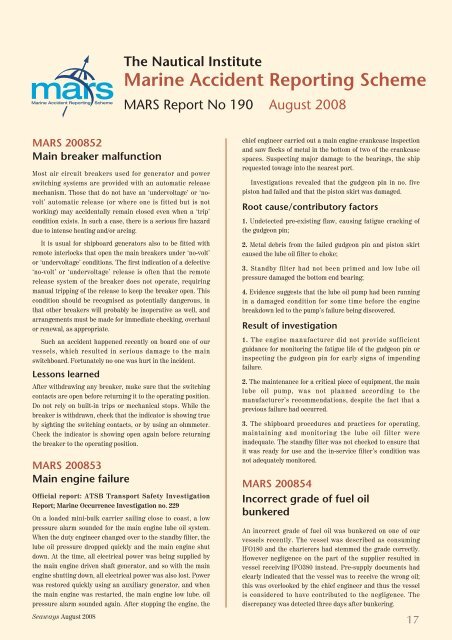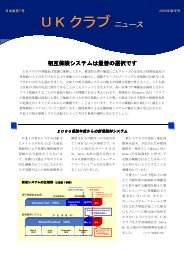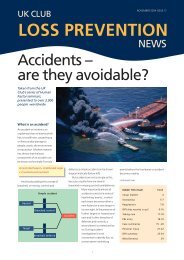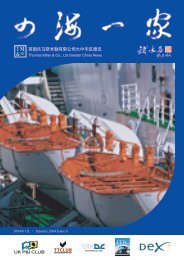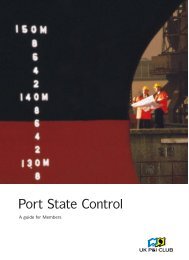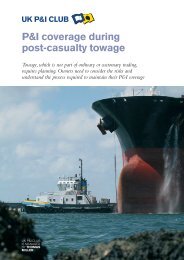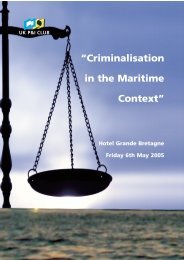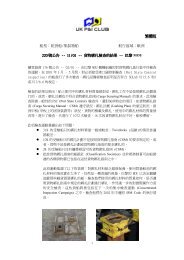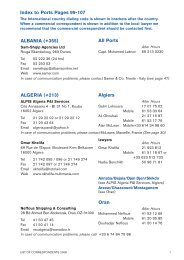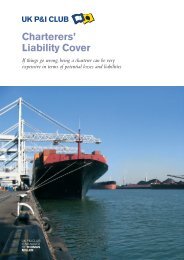Create successful ePaper yourself
Turn your PDF publications into a flip-book with our unique Google optimized e-Paper software.
The Nautical Institute<br />
Marine Accident Reporting Scheme<br />
MARS Report No <strong>190</strong> August 2008<br />
MARS 200852<br />
Main breaker malfunction<br />
Most air circuit breakers used for generator and power<br />
switching systems are provided with an automatic release<br />
mechanism. Those that do not have an ‘undervoltage’ or ‘novolt’<br />
automatic release (or where one is fitted but is not<br />
working) may accidentally remain closed even when a ‘trip’<br />
condition exists. In such a case, there is a serious fire hazard<br />
due to intense heating and/or arcing.<br />
It is usual for shipboard generators also to be fitted with<br />
remote interlocks that open the main breakers under ‘no-volt’<br />
or ‘undervoltage’ conditions. The first indication of a defective<br />
‘no-volt’ or ‘undervoltage’ release is often that the remote<br />
release system of the breaker does not operate, requiring<br />
manual tripping of the release to keep the breaker open. This<br />
condition should be recognised as potentially dangerous, in<br />
that other breakers will probably be inoperative as well, and<br />
arrangements must be made for immediate checking, overhaul<br />
or renewal, as appropriate.<br />
Such an accident happened recently on board one of our<br />
vessels, which resulted in serious damage to the main<br />
switchboard. Fortunately no one was hurt in the incident.<br />
Lessons learned<br />
After withdrawing any breaker, make sure that the switching<br />
contacts are open before returning it to the operating position.<br />
Do not rely on built-in trips or mechanical stops. While the<br />
breaker is withdrawn, check that the indicator is showing true<br />
by sighting the switching contacts, or by using an ohmmeter.<br />
Check the indicator is showing open again before returning<br />
the breaker to the operating position.<br />
MARS 200853<br />
Main engine failure<br />
Official report: ATSB Transport Safety Investigation<br />
Report; Marine Occurrence Investigation no. 229<br />
On a loaded mini-bulk carrier sailing close to coast, a low<br />
pressure alarm sounded for the main engine lube oil system.<br />
When the duty engineer changed over to the standby filter, the<br />
lube oil pressure dropped quickly and the main engine shut<br />
down. At the time, all electrical power was being supplied by<br />
the main engine driven shaft generator, and so with the main<br />
engine shutting down, all electrical power was also lost. Power<br />
was restored quickly using an auxiliary generator, and when<br />
the main engine was restarted, the main engine low lube. oil<br />
pressure alarm sounded again. After stopping the engine, the<br />
chief engineer carried out a main engine crankcase inspection<br />
and saw flecks of metal in the bottom of two of the crankcase<br />
spaces. Suspecting major damage to the bearings, the ship<br />
requested towage into the nearest port.<br />
Investigations revealed that the gudgeon pin in no. five<br />
piston had failed and that the piston skirt was damaged.<br />
Root cause/contributory factors<br />
1. Undetected pre-existing flaw, causing fatigue cracking of<br />
the gudgeon pin;<br />
2. Metal debris from the failed gudgeon pin and piston skirt<br />
caused the lube oil filter to choke;<br />
3. Standby filter had not been primed and low lube oil<br />
pressure damaged the bottom end bearing;<br />
4. Evidence suggests that the lube oil pump had been running<br />
in a damaged condition for some time before the engine<br />
breakdown led to the pump’s failure being discovered.<br />
Result of investigation<br />
1. The engine manufacturer did not provide sufficient<br />
guidance for monitoring the fatigue life of the gudgeon pin or<br />
inspecting the gudgeon pin for early signs of impending<br />
failure.<br />
2. The maintenance for a critical piece of equipment, the main<br />
lube oil pump, was not planned according to the<br />
manufacturer’s recommendations, despite the fact that a<br />
previous failure had occurred.<br />
3. The shipboard procedures and practices for operating,<br />
maintaining and monitoring the lube oil filter were<br />
inadequate. The standby filter was not checked to ensure that<br />
it was ready for use and the in-service filter’s condition was<br />
not adequately monitored.<br />
MARS 200854<br />
Incorrect grade of fuel oil<br />
bunkered<br />
An incorrect grade of fuel oil was bunkered on one of our<br />
vessels recently. The vessel was described as consuming<br />
IFO180 and the charterers had stemmed the grade correctly.<br />
However negligence on the part of the supplier resulted in<br />
vessel receiving IFO380 instead. Pre-supply documents had<br />
clearly indicated that the vessel was to receive the wrong oil;<br />
this was overlooked by the chief engineer and thus the vessel<br />
is considered to have contributed to the negligence. The<br />
discrepancy was detected three days after bunkering.<br />
Seaways August 2008<br />
17
The supplier accepted responsibility for the wrong supply<br />
and the incorrect oil was de-bunkered and the correct grade<br />
was supplied. However, the vessel was put off hire during the<br />
time taken for this operation.<br />
MARS 200855<br />
Mooring failure, pollution<br />
Source: IMO Flag State Implementation Sub-committee 11<br />
An oil tanker was moored to, and discharging to, a single<br />
point mooring (SPM) buoy. At some time during these<br />
operations, the chain stopper opened and the chafing chain<br />
was released. The ship was then moored only by a pickup rope<br />
that parted shortly thereafter. As the vessel drifted from the<br />
monobuoy, the cargo hoses parted and approximately 12<br />
tonnes of oil spilled into the sea.<br />
Root cause/contributory factors<br />
1. The bridge monitor that was used to control the cargo<br />
operation also used the same function keys to control different<br />
operations. The screen colour was different for each<br />
operation; however, the function keys and their sequence were<br />
not unique to a given operation.<br />
2. It is believed that one of the officers performing cargo<br />
operations unintentionally opened the chain stopper and<br />
released the chafing chain while attempting to secure a<br />
forward hydraulic pump.<br />
3. The function key sequence was the same for each operation<br />
and only the screen colour provided an indication as to which<br />
operation was being performed.<br />
Lessons learned<br />
1. Ergonomics, in the form of operator-machine interface, can<br />
be a critical element in shipboard safety.<br />
2. Ships’ crews should display warning signs where there is a<br />
possibility of confusion in the operator-machine interface.<br />
MARS 200856<br />
Ro-ro ships – manoeuvring<br />
difficulties<br />
An inbound pure car and truck carrier (PCTC) was<br />
approaching the pilot station at her scheduled time, in very<br />
confined waters. A gale warning was in force and with only<br />
two miles to go to the pilot embarkation point, the wind<br />
suddenly increased and pilotage services were abruptly<br />
suspended.<br />
The master was instructed to await further orders<br />
and decided to head back to open waters rather than wait in<br />
the confined area or anchor there. The wind caught the<br />
beam of the high-freeboard and low draught vessel, and<br />
started setting her on to the lee shore, less than two miles<br />
downwind. Using full rudder and engine power, and<br />
transmitting appropriate signals on the air horn and<br />
VHF radio, the master just managed to turn the ship’s head<br />
into the wind and execute the 180-degree turn and head out to<br />
open sea.<br />
Once out of the lee of the land, the full force of the gale<br />
caused the ship to move sideways at about five knots, even<br />
with the engine going on harbour full ahead. The vessel<br />
remained stubbornly beam on to the wind despite all attempts<br />
to heave to with the head into the sea and swell.<br />
This type of vessel has been rightly described as a<br />
‘ping-pong ball on the water’ and under high wind conditions,<br />
ro-ros are almost impossible to control or manoeuvre.<br />
At the first indication of approaching strong winds, masters of<br />
ro-ros and similar high-sided vessels must not hesitate to<br />
leave port or confined waters and anchorages and head out to<br />
open sea. Maintaining a safe position under way in the<br />
lee of a high offshore island is a safe option, provided the<br />
location and predicted movement of the weather system<br />
is known.<br />
If sailing from port is not possible, ships have been kept<br />
alongside with continuous use of tugs, and, in uncrowded<br />
anchorages, mooring to two bower anchors may considered,<br />
but with engines in full readiness until the wind has abated.<br />
Even with full scope of chain on both anchors, ro-ro vessels<br />
tend to yaw violently in strong winds and the ‘jerk’ at the<br />
extremity of each yaw may cause the anchors to drag,<br />
especially if the holding ground is less than ideal.<br />
Mariners whose vessels may be navigating or lying at<br />
anchor near a ro-ro vessel in high winds, must allow for a<br />
greater margin of safety.<br />
The International Command Seminar Series 2008<br />
The Command Team and the DP – Expectations, training, qualifications and competence<br />
The Nautical Institute, in conjunction with its branch<br />
network and in partnership with the International<br />
Federation of Ship Masters’ Associations (IFSMA), the<br />
Institute of Marine Engineering, Science and Technology<br />
(IMarEST), the Corporation<br />
of Trinity House and the<br />
Honourable Company of<br />
Master Mariners (HCMM),<br />
is pleased to be hosting the<br />
2008 series of International<br />
Command Seminars.<br />
The theme for this series is<br />
the relationship between<br />
the Designated Person (DPA), the command team afloat and<br />
the rest of the industry.<br />
The first seminar was held in Antwerp (see pp 10-12)<br />
The next International Command Seminars will be held in:<br />
● Panama - 9-10 September 2008 *<br />
● Glasgow – 9 October 2008<br />
● Hong Kong – 6 November 2008<br />
*Thanks to RTI Marine for its sponsorship of the Panama<br />
Seminar, which will be held at the Four Points by Sheraton<br />
hotel, Panama City.<br />
For more information, download brochure from<br />
www.nautinst.org<br />
18<br />
Seaways August 2008
MARS 200857<br />
Bent derrick boom<br />
▲ This photograph shows a bent derrick boom. Seafarers must carefully<br />
check their ship’s gear for such defects. This defect is usually caused by<br />
over-stressing the system. Following regulations, such a derrick must be<br />
unshipped, permanently repaired under class supervision, re-mounted, prooftested<br />
and certified before being taken back into use.<br />
MARS 200858<br />
Derrick accident causes fatality<br />
Source: Standard P&I Club, Safety issue, December 2007<br />
A new ship was discharging steel plates with own cargo gear.<br />
While the derrick was lifting two steel plates slung together,<br />
the topping lift wire broke and the plates fell. One stevedore<br />
was killed at the scene and three others were badly injured.<br />
The accident was attributed to a seizure of the centre pulley<br />
bearing, causing wear and breakage of the lifting wire due to<br />
contact with the pulley sheave. The shipowner had established<br />
a programme of routine maintenance, which the crew should<br />
have performed under the supervision of the chief officer. It<br />
would appear that this had not been done properly and the<br />
sheave, because of its position and accessibility, had been<br />
overlooked.<br />
The additional wear and tear leading to the wire parting<br />
must have occurred over a period of time and should have<br />
been noticed by the crew. The faulty bearing was supplied by<br />
the shipbuilder; however the ship had been in service for<br />
about six months and the owner should have ensured that all<br />
equipment was checked and serviced regularly.<br />
All wires, sheaves, gears and other moving parts must be<br />
checked and greased as soon as possible after delivery, and at<br />
regular intervals thereafter.<br />
MARS 200859<br />
Collision with sinking and fatalities<br />
Official report: Preliminary Inquiry no. 3 2006;<br />
www.mardep.gov.hk/en/publication/pdf/mai060823.pdf<br />
A container ship collided with a small general cargo ship at<br />
night in clear weather under slight sea conditions,<br />
immediately after which the smaller cargo ship sank, with the<br />
loss of three crew members.<br />
Results of inquiry<br />
1. The container ship had sailed from port about two hours<br />
before the incident and having disembarked the pilot,<br />
departed the fairway, and was increasing to her normal sea<br />
speed of 24 knots. The master and the third officer were on<br />
the bridge at the time of the incident.<br />
2. The cargo ship was on a coastal voyage with steel cargo and<br />
at the time of the incident; the bridge was manned by the master<br />
and an officer, both of whom went missing, presumed dead.<br />
3. The incident occurred within the surveillance area of the<br />
port’s VTS, so the tracks of both vessels were recorded and<br />
used in this inquiry. Before the collision, the container ship<br />
was on a course of 149ºT (and was altering rapidly to 180ºT to<br />
avoid collision) and at a speed of about 20 knots. The cargo<br />
ship maintained a course of about 229ºT at a speed of about<br />
8 kts until the collision.<br />
Root cause/contributory factors<br />
1. The cargo ship, which was the give-way vessel, appeared<br />
to have failed to comply with Rule 15 of the Colregs, to keep<br />
out of the way of the container vessel in a crossing situation.<br />
2. The container ship, being a stand-on vessel, appeared to<br />
have failed to comply with Rule 8 of Colregs, to take early<br />
action to slow down, stop or reverse her engine in order to<br />
avoid collision.<br />
3. Fatigue, alcohol and drugs were not found to have<br />
contributed to this incident.<br />
Lessons learned<br />
1. Masters and navigating officers should comply with<br />
Colregs at all times.<br />
2. When a close quarters situation or risk of collision is likely<br />
to develop, early action to avoid collision should be made in<br />
compliance with Colregs.<br />
Feedback<br />
MARS 200814<br />
Propeller damaged by own refuse<br />
I'm somewhat surprised that this report has been issued<br />
without any comment. Surely, there is some convention which<br />
precludes dumping waste of this sort at sea? Even if there isn't,<br />
I would imagine the company's environmental policy might<br />
(should?) preclude this sort of action. In any event, the report<br />
tries to give advice but actually demonstrates what a reckless<br />
operation took place, without any safe management. Amazing.<br />
■ Editor’s note: Marpol does not specifically address<br />
discarded ship’s spares under its annexes, but such refuse<br />
may reasonably be considered as ‘operational waste’<br />
under Annex V (Garbage), provided they do not contain or<br />
are not ‘contaminated’ with substances that come under<br />
any of the other Annexes: oil, noxious liquid substances<br />
(NLS), harmful substances, sewage and environmentally<br />
damaging substances. The dumping of the discarded heat<br />
exchangers on the ‘high seas’ in this case did not<br />
contravene Marpol if it was done more than 25 miles from<br />
nearest land outside special areas. However, lack of<br />
Seaways August 2008<br />
19
seamanship, prudence and internal communications seem<br />
to have been the main reasons for the damage sustained<br />
by the propeller.<br />
Feedback<br />
MARS 200824<br />
Crate dropped during lowering<br />
There are various comments on this in the entry but I<br />
would take this opportunity to highlight the following:<br />
● The value of the goods contained within the crate can<br />
easily be established, but the centre of gravity of the contents<br />
is (or was) a mystery. Based on the foregoing statement, the<br />
suggested method of proper slinging was incorrect as shown<br />
in the diagram.<br />
● The only positive method of restraining any movement<br />
would be to sling it as shown in the diagram below. This<br />
method is an age-old traditional method known as a ‘body and<br />
soul’ slinging arrangement.<br />
■ Editor’s note: While this arrangement is definitely<br />
superior, in the original report, it was mentioned that the case<br />
was unusually tall, which would probably mean that each of<br />
the pair of slings required would measure upwards of, say,<br />
15 metres in length. Ideally, an efficient slinging arrangement<br />
for awkward packages should be provided by the packer.<br />
From the report, it appears either that the slings used were<br />
not long enough for this method or that the ship could not<br />
produce or improvise a pair of slings of suitable length.<br />
The method suggested by the Editor involves shorter<br />
slings like those illustrated in the original report and the<br />
‘tightening’ is achieved simply by a person holding or<br />
tapping down the unloaded eye as the weight is taken by the<br />
lifting appliance. This method has been successfully used by<br />
stevedores the world over for decades, if not centuries.<br />
Feedback<br />
MARS 200832<br />
Near loss of tug<br />
All tugs should have an emergency hook release mechanism.<br />
For overall safety, a tug’s skipper must ensure, among other<br />
things, the following are also complied with before<br />
commencing a towing operation:<br />
1. Tow winch(es) operation and quick release(s) checked, as<br />
applicable<br />
2. Towing ropes / wires / gear are in good condition<br />
3. The bridge radio is functioning correctly<br />
4. Ship's whistle, fire and general alarms are tested<br />
5. All watertight doors and openings on and below the main<br />
deck are battened down.<br />
Vessels must not tow an idle escort tug. The Nautical<br />
Institute publication, Tug Use in Port, by Captain Henk<br />
Hensen FNI includes valuable information on the safe<br />
deployment of tugs.<br />
MARS: You can make a difference!<br />
Can you save a life, prevent injury, or contribute to a more effective shipping community?<br />
Everyone makes mistakes or has near misses but by contributing reports about these events to<br />
MARS, you can help others learn from your experiences. Reports concerning navigation, cargo,<br />
engineering, ISM management, mooring, leadership, ship design, training or any other aspect of<br />
operations are always welcome.<br />
MARS is strictly confidential and can help so many – please contribute.<br />
Editor: Captain Shridhar Nivas MNI<br />
Email: mars@nautinst.org or MARS, c/o The Nautical Institute,<br />
202 Lambeth Road, London SE1 7LQ, <strong>UK</strong><br />
The Nautical Institute gratefully acknowledges sponsorship provided by:<br />
North of England P&I Club, The Swedish Club, <strong>UK</strong> P&I Club,<br />
The Marine Society and Sea Cadets, Britannia P&I Club,<br />
Lloyd’s Register-Fairplay, Safety at Sea, Sail Training International<br />
20<br />
www.nautinst.org/mars<br />
Search the MARS<br />
database online<br />
Seaways August 2008


